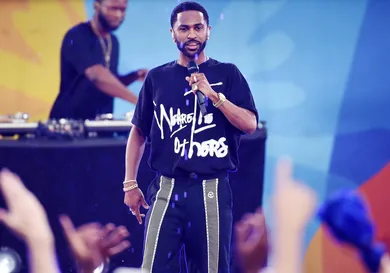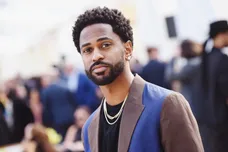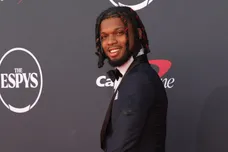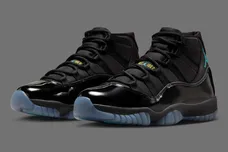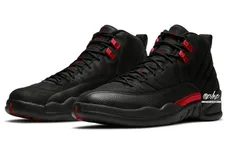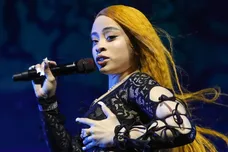Big Sean has a talent of turning his Ls to Ws. While the Detroit rapper does not typically enter the "top five" discussion, and the quality of his bars have come under scrutiny in the past, he's always found a way to bounce back (!) with an undeniable song. He’s a successful rapper – Grammy nominations, multiple hit songs, and several platinum albums. He’s a goofy, charming guy who can still be corny, shameless, and unafraid to commit to the dumbest of puns. And we love him for it.
This is the start of a new feature at HotNewHipHop where we'll break down a rapper’s discography in two different mediums: their mixtapes versus their albums. Some rappers work better in the mixtape medium and vice versa. Kicking it off, we’ll look to break down how Big Sean operates as an artist when in mixtape mode versus album mode.
Get your keyboards at the ready for the comment section debate.
The Highs & Lows
Kevin Winter/Getty Images
While the distinction between mixtapes and albums have become blurred in recent years, the general idea of mixtapes acting as a building ground for a new or upcoming artist hasn’t changed. For the rapper, the mixtape can represent a no-frills vehicle for their work. Meanwhile, the phrase ‘album mode’ can come with enough baggage to cripple even the most hardened of artists. In the case of Big Sean, his early mixtapes, a mix of original music and freestyles, were adeptly used to further develop his rap persona and establish a growing fanbase.
Big Sean meeting Kanye West at a Detroit radio station, which would lead to his signing on G.O.O.D. Music, played a big role in the narrative for his Finally Famous series of mixtapes, which would eventually culminate in his debut album of the same name. His breakout for the wider mainstream audience would arrive on the Cruel Summer single “Clique,” a posse track built from Sean’s own demo. “Clique” and “Mercy” are the two tracks that showcased a Big Sean in full bloom, ready to seize his moment. But those tracks were, in fact, the culmination of seven years of artist development documented in the Finally Famous mixtape series.
Big Sean came up in the era of Internet blog rap, when indie and alternative rappers built fanbases entirely online. The sound of blog rap was amorphous, with rappers like Mac Miller, Lil B, Kid Cudi, Curren$y and the Cool Kids all fitting under one umbrella. Around this time, mixtapes were making a shift from rappers simply riffing over popular beats to an artistic showcase that used original production, Sean was caught somewhere in the middle. He played this to his advantage and the sound of the Finally Famous series reflected this too: diverse and looking to please just about everyone. For the fans of G.O.O.D. Music, Sean worked in the overt Kanye influences and allusions: goofy wordplay built on a bedrock of Chicago soul. There were the freestyles for 'heads looking to hear Sean’s rapping ability and technique. His choice in collaborators ran the gamut too; you could expect to see indie-leaning acts such as Curren$y, Wiz Khalifa, Dom Kennedy and Chuck Inglish of the Cool Kids but also guys like Drake, YG, Bun B and Tyga.
The Finally Famous series was Sean’s sandbox to explore – there was no idea worth discarding. It’s what made hearing Finally Famous, the debut album that his mixtapes were leading up to, ultimately so disappointing for fans. Released in 2011, you could blame it on the major label machinations that sought to make debut rap albums blockbuster events – it sank albums like Thank Me Later and Attention Deficit by ignoring the rapper at the center of it all. Finally Famous is a world away from the mixtapes of past; it’s streamlined, uneven, and it magnified the worst aspects of Big Sean’s charisma by tenfold, even if it did spawn several hits such as "Marvin & Chardonnay" and "Dance (A$$)."
In comparison, Detroit felt a lot more refined. Released on the heels of Finally Famous (the album), Detroit marked another step in Big Sean’s growth as a rapper, embracing the concept of a mixtape that felt like an album by enlisting rappers to record narrative voiceovers and using a smaller selection of producers to give it a cohesive feel. More importantly, it diverged from the bubblegum-esque sound explored on Finally Famous, in favour of seeking new vistas. In retrospect, Detroit would later serve as a blueprint for future albums in Sean's discography. Its laser focus has been something Sean has sought to maintain with his later releases. You can see its conceptual approach in I Decided., with voiceovers and skits helping to bridge the songs together.
Dark Sky Paradise would break away from that, kicking off a trend of Big Sean full-length projects that attempt for "classic" status largely by their ambition, cohesion, and gravitas. In many ways, album mode for Big Sean can be both a blessing and a curse – his drive and ambition yields improvements each time. Dark Sky Paradise was leaps and bounds above Hall of Fame in quality, while I Decided. set the bar even higher – but even with these improvements, do they hit the fan sweet-spot? Sean has shown he can step it up when he’s feeling the pressure, but perhaps that same pressure has a tendency of sapping his albums in a way. It's as though his vision gets clouded and confused; the rapper himself lost on the path towards a "bulletproof" album. When Hall of Fame got tepid reviews and stalled commercially, Sean would later tell NPR that Detroit succeeded by focusing on his own ideas, while Hall of Fame was influenced by outlier advice.
Beat Selection
Robin L Marshall/Getty Images
When it comes to production choices, Big Sean in album mode tends to favour a little bit of everything. You can expect trap (fun fact: one of Metro Boomin’s earliest beat placements was on Finally Famous 3, flipping Adele for the sentimental “Hometown”) and given his G.O.O.D. Music affiliation, the retro-soul Kanye is renown for. “I Don't Fuck With You" starts with a D.J. Rogers sample, a choice flip that only Kanye could have picked before the song dips into a DJ Mustard-finessed bounce. “Fire,” one of the best songs on Hall of Fame, was actually intended for Kanye and "I’m Gonna Be" could easily pass for a Late Registration-era production, drawing a tenderness and naivety out of Sean rarely seen elsewhere.
Mixtape Sean, on the other hand, is a, well, mixed bag. When it came to beats, the Finally Famous tapes featured some of the most disparate strands of the blog rap era. It was a universe where songs like “Billionaire” could sit next to “Five Bucks (5 On It)” and "Home Town" with very little reasoning. There was no beat he’d say no to, and part of his appeal at the time came from picking out-of-pocket beats to stunt on. Big Sean would go as far as rapping over beats like Kanye’s “Say You Will” and Santigold’s “Starstruck,” looking to appeal to anyone willing to listen. Detroit narrows the scope but gets away with including songs like "Do What I Gotta Do” and “Woke Up,” which function like throwbacks to the old Sean.
Lyrical Approach
Jerritt Clark/Getty Images for Rolling Stone
Big Sean infamously claimed to have the lyrical abilities of Big L, Biggie Smalls and Jay-Z rolled in one. As the reaction to the infamous “Control” proved, Big Sean may not be in most people’s "Top 10's" but the gap between Sean and his contemporaries, like Drake and J. Cole, is a lot closer than you think. For one thing, Big Sean deserves credit for popularizing one early 2010s rap flow: the hashtag flow. He didn’t invent it, but he definitely brought it to prominence, pairing it with his penchant for stringing witty one-liners to create something every popular rapper between 2009 and 2011 seemingly adopted. Listen to “Supa Dupa” for one of the best examples of hashtag flow in motion. Rather than sprinkle it in sparingly, Sean employs the flow for most of the song, fully committing. If these bars were personified, they’d be wearing circa-2012 coloured snapbacks. Sean Don wasn’t kidding when he claimed he “could hear a little bit of me in all your favourite rappers” in DJ Khaled’s “Holy Key.”
Big Sean’s mixtapes tend to be more freeform in content, the relaxed atmosphere allowing for more playful Sean. On the other hand, the albums could benefit from some levity – they tend to work in concepts and emphasize the main tenets of his narrative: Big Sean cares about his family and loved ones, he’s worked harder than everyone, he’s going to be the best rapper and put on Detroit in the process, etc. Several albums into his career and Big Sean has made it clear he’s not going to rap about much more than the world outside his window but he’s calmed his approach, transforming from the wild, careening style of past mixtapes to a careful, refined lyrical eye.
Yet if there’s one flaw that continues to persist in Big Sean’s writing, it’s his obsession with puns. Big Sean is a writer in love with great wordplay; who can forget his "ass shake/ass quake/ass-tate/ass tray" sequence that starts off his "Mercy" verse or when he told us he needed a “broad on the floor year 'round like season tickets" on Drake’s “All Me.” Yet, he’s also capable of wrecking a song or performance with the right (or rather, wrong) pun. One notable example: "Imma want the beef, broccoli, and asparagus" Sean raps on "Fuck My Opponent" before later finishing with "Fuck you with a Ron Jeremy dick.” Sean has a hit-or-miss ratio when it comes to puns, and this is equally true whether it's on an album or a mixtape.
Choice Cuts
Bennett Raglin/Getty Images
MIXTAPE SEAN
"Supa Dupa Lemonade"
"Fat Raps (Remix"
"Mind Playing Tricks On Me"
"Higher"
ALBUM SEAN
"Voices In My Head/Stick to the Plan"
"All Your Fault"
"Fire"
"I Don’t Fuck With You"
"I Do It"
Shout out your favourite Mixtape versus Album Big Sean tracks in the comments, and let us know your assessment of the rapper.
